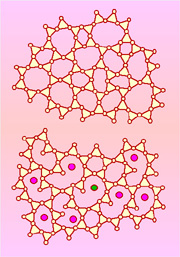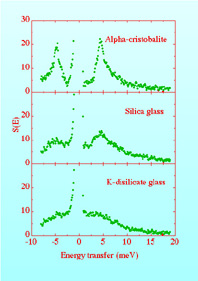

Following our recent work on the Rigid Unit Mode (RUM) model for crystalline silicates, we wondered whether the same ideas might also apply to silicate glasses. My own feeling is that there are significant differences between simple crystalline silicates (such as quartz and cristobalite) and silica glass that arise from the lack of symmetry in the amorphous state, and it is not immediately clear to me that one should expect to see the analogues of low-energy RUMs, called "floppy modes" in silica glass. On the other hand, it might be expected that silicates with non-bridging Si-O (or Al-O) bonds in the tetrahedra could have a lot of floppy modes. This is in agreement with existing general theoretical ideas about floppy modes in glasses.

Our first part of this work was to measure the low-energy spectra (0-20 meV) in a suite of samples using the PRISMA spectrometer at ISIS. We performed measurements on tetragonal cristobalite, taking this as a reference material since our RUM analysis shows that there are not many RUMs in this phase, amorphous silica, and a potassium disilicate with a significant number of non-bridging Si-O bonds. There are several potential interesting comparisons in this suite, including the comparison of cristobalite with silica glass, and the comparison of the disilicate and silica glasses.

We were also interested in how the famous "Boson peak" enters the situation, and to ask whether it has anything to do with the floppy modes.
Our conclusions from our first measurements were a) that the Boson peak is present in both the cristobalite and amorphous phases of silica, and we have identified this with the transverse acoustic excitations with small wavelengths; b) that there is a non-zero number of floppy modes in amorphous silica; c) that the energy range for floppy modes is 0-5 meV, similar to that found in cubic cristobalite; d) there are so many floppy modes in the disilicate glass that they mask the Boson peak.
Full credit is due to my collaborators, Mark Harris, Manoj Gambhir, Ian Swainson, Alex Hannon, and John Parker
Our papers on this subject include (in reverse chronological order):
M T Dove, M J Harris, A C Hannon, J M Parker, I P Swainson and M Gambhir, "Floppy modes in crystalline and amorphous silicates". Physical Review Letters (in press, submitted 21/8/96)
This gives a reasonable account of our first attempt at our story for glasses. Here we compare the low-energy excitation spectra for tetragonal cristobalite, silica glass, and a K-dilisilicate glass, as described above.
M T Dove and M J Harris, "New light on the dynamics of silicate glasses", in ISIS 96, The ISIS Facility Annual Report 1995-96, pp 48-49, 1996.
This is a shorter account, but has some nice pictures.
Link back to ...